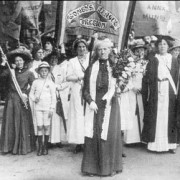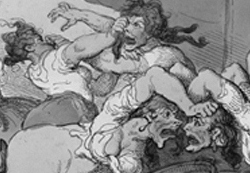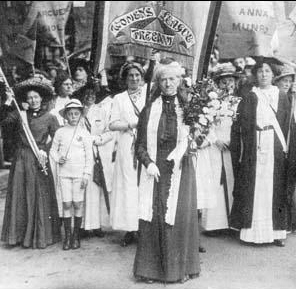MONTHLY BLOG 156, Tracking Social Media: It’s High Time for Effective Regulation
If citing, please kindly acknowledge copyright © Penelope J. Corfield (2023)

Yes, there are a range of good reasons for authorial anonymity. These are fully acknowledged in my MONTHLY BLOG/155 (November 2023).1
Yet … humans are tricky creatures. That trickiness, of course, helps to explain why authors so often seek anonymity in the first place. They may need to be protected in order to speak out against ruthless or corrupt employers.
Nonetheless, humans can also use secrecy, not just to protect themselves from harm, but also to harm others. Anonymous authors can lie, as well as speak truth to power. Indeed, some authors, writing anonymously, discover that the normal social restraints are subtly loosened. They find within themselves hitherto unsuspected levels of venom and hostility.
The result is that anonymous foul-speaking, trouble-stirring trolls have become a contemporary social curse, especially on social media. Trolling onslaughts can include cases of cyber-bullying; threats to the recipients and their families; stalking; and sexual harassment. All such behaviours are crimes. Yet they are masked by secrecy – and quasi-justified by claims of ‘free speech’.
Lawyers will, of course, point out that – these days – human rights are all embedded in frameworks of law. Free speech is an invaluable thing. No question. But it is not utterly untrammelled. There are laws world-wide which attempt to control written defamation (libel) and its spoken equivalent (slander).2 In effect, the legal framework tries to balances the right to freedom of speech with the right to protection from defamation, harassment, bullying and other criminal abuses.
However, today, the plurality of publication outlets, via the explosion of social media, has made those laws very hard to enforce. So what follows?
Historical practice is relevant here. When print publications began to multiply across sixteenth-century Europe, a de facto case law emerged. It became accepted that publishers are legally responsible for materials that appear under their imprimatur. Hence they tried to avoid publishing works that could be construed as defamatory, obscene, blasphemous, inciting criminal behaviour, breaching someone else’s copyright, or otherwise illegal.3 Quite a list!
As part of that responsibility, it has also become established that published works should show the name of the publisher, plus the location and date of the publication.4 Thus, while authors can remain anonymous (or can write under a pseudonym), their print publishers are ‘on the record’.
Similarly, a printed newspaper has the right to protect its sources. Some information is derived from sources who do not want to be named. But the newspaper owners and their editorial teams take legal responsibility for whatever is published. (Hence they generally double check their sources wherever possible). It means that ideas and arguments – and statements about individuals and causes – are not just bandied around in a legal void.5
When it comes to the internet, however, the explosion of social media – and the ease with which everyone has access – has dramatically changed the playing-field. The evolving legal framework was trying to balance an individual’s right to free speech with the parallel right to reasonable protection. There is also a collective social interest at stake. It is highly important that people have reliable access to the stock of knowledge and are not being misled by ‘fake news’ or ‘fake information’.
Research shows that using social media regularly can have both positive and negative effects on individuals.6 One adverse impact is a sense of personal impunity through anonymity. That has the effect of weakening normal social- and self-controls. People – and groups – indulge in over-the-top hatreds and invective. And so a dangerous ‘hate culture’ is born.
Furthermore, an unregulated social media ‘free-for-all’ is dangerous not only for the venom and/or errors of expressed opinions but also for the extreme velocity with which everything is circulated – unchecked. So people are at risk of being fed on a daily diet of false-information and fake facts, which seem to be beyond checking and correction. Put at its most extreme, the entire corpus of careful and verified knowledge, which has been patiently accumulated and tested by humans over successive generations, may be at risk.
What is to be done? There must be an internationally agreed legal framework for regulating the internet (and for the ‘dark web’), just as there are legal frameworks for print culture. Easy to say! Hard to achieve! But the bedrock must be that web-publishers take responsibility not for every detail but for the broad reliability and non-criminality of the material which they broadcast. And each social transmission should include (ideally) the name of the sending account; (invariably) the name of the transmission agency (equivalent to the print publisher); and (invariably) the date/time of transmission.
Individual contributors, meanwhile, should be encouraged to take full ownership of their own views. In normal circumstances, they should fly under their own colours, with full name and identification.
But, as already agreed, at times there are good reasons for remaining anonymous. In such circumstances, someone else must step up and take responsibility. Every communication must have a known publisher, who can be tracked and held accountable.
To repeat: humans are tricky creatures. They have so many good qualities – and the reverse. What they have learned, painfully and slowly, is that their societies operate successfully only within frameworks of laws and regulation. Sure, there are disputes all the way about how such frameworks are operated in practice. No system will be perfect. But that’s not the point.
Crucially, the big and ultra-serious point is that, without properly enforced regulation, today’s social media will strangle the life and knowledge out of all day-to-day human associations. The question is therefore not whether social media need a proper framework of regulation – but, rather, how the deed is to be done. There’s no call for censorship. But there is an urgent need for regulation.
Unsurprisingly, today there is much debate on this hot topic.7 There are many helpful suggestions out there. So it’s now time for a big public debate – followed by decisive action! Collectively, humanity is today facing many testing problems. It’s time to apply our collective ingenuity and creativity to resolve them. We must have transparency within social media systems, at specified levels and in specified ways. We must curb the circulation of fakery, misinformation, hatreds, and criminality.
Humanity is born ingenious. And it must use that ingenuity to keep the best of our inventions and to curb the excesses. It’s a global battle that we need to win. After all, if we fail, then we have nothing to lose but our brains.
ENDNOTES:
1 PJC, ‘The Anonymous Author: Seeking Justified Privacy or Avoiding Responsible Transparency?’ BLOG/ 155 (Nov. 2023) on www.penelopejcorfield.com/monthly-blogs.
2 See https://en.wikipedia.org/wiki/Defamation (viewed 28 Nov. 2023).
3 For the UK, see e.g. J. Kirsch, Kirsch’s Handbook of Publishing Law: For Authors, Publishers, Editors and Agents (Acrobat Books, 1995).
4 G. Cole, ‘The Historical Development of the Title Page’, Journal of Library History, Vol.6, no 4 (1971), pp. 303-16.
5 In England, the current legal situation is governed by the 2013 Defamation Act, supplemented by the common law.
6 Pew Research Centre (USA), ‘The Future of Free Speech, Trolls, Anonymity and Fake News Online’ (29 March 2017), in https://www.pewresearch.org/internet/2017/03/29/the-future-of-free-speech-trolls-anonymity-and-fake-news-online (viewed 29 Nov. 2023).
7 See thoughtful discussions, from a variety of perspectives, in J. Naughton, ‘Has the Internet Become a Failed State?’, The Observer, 27 Nov. 2016; A. Macrina and T. Cooper, Anonymity: Library Futures (Chicago, 2019); D. Ghosh, ‘Are We Entering a New Era of Social Media Regulation?’ Harvard Business Review (Jan. 2021): https://hbr.org/2021/01/are-we-entering-a-new-era-of-social-media-regulation (viewed 29 Nov. 2023); J. Susskind, ‘We Can Regulate Social Media without Censorship – Here’s How’, Time Magazine, 22 July 2022); M. MacCarthy, ‘Transparency is Essential for Effective Social Media Regulation’, Brookings Institution Washington – Commentary (Nov. 2022): https://www.brookings.edu/article/transparency-is-essential-for-effective-social-media-regulation/ (viewed 29 Nov. 2023).
For further discussion, see Twitter
To read other discussion-points, please click here
To download Monthly Blog 156 please click here






